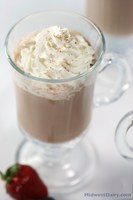Prairie Fare: Prepare Yourself for Winter Snow Removal
(Click an image below to view a high-resolution image that can be downloaded)
By Julie Garden-Robinson, Food and Nutrition Specialist
NDSU Extension Service
I opened the garage door and was met by a 5-foot wall of snow. I almost gave up and shut the door. However, I accepted nature’s challenge and shoveled a tunnel large enough to maneuver a snow blower.
I never have tamed a bucking bronco, but this snow blower threw me around as it took bites of packed snow and kicked it out of the chute. I was working muscles I didn’t know I had. My eyelashes were frozen and a thick layer of snow covered me when I retired the snow blower after an hour.
This was my regular 6 a.m. workout during the winter of 2008-2009, which was followed by the spring flood of 2009. My husband was recovering from surgery that year.
Of course, I said I could handle the snow removal instead of hiring it done. What was I thinking? We had set up a makeshift hospital room on the main floor of our house. My husband wasn’t supposed to do any strenuous activities or walk on icy driveways.
In my impersonation of Superwoman, I also said I would continue removing snow at our neighbor’s house. He had a really long driveway. By the end of the winter, I easily could throw sandbags along the river to hold back floodwaters.
I turned over the snow blower at the end of the 2009 season. I am happy to provide encouragement and a warm beverage for my husband when he is done clearing snow. I also bought a new shoveling tool that can be pushed down the driveway easily when we have light snowfalls. I like to use that, too.
We have entered winter in North Dakota, and some areas of the state have accumulated large amounts of snow already. Now is the time we need to work our muscles safely, dress appropriately, protect our skin from frostbite and take in ample fluids to stay hydrated.
Whether you have a snow blower or a shovel, exercise some caution when removing snow. Shoveling snow is a form of moderate to vigorous activity. If you have a history of heart disease, discuss your physical activity with a health-care provider before taking on a potentially strenuous task such as snow removal. Consider these tips:
- Dress in several layers so you can remove a layer as needed. Remember that synthetic fibers help wick away perspiration better than natural fibers. Besides a warm coat, be sure to wear warm socks, a stocking hat, scarf and mittens to cover exposed skin.
- Warm up by walking in place and stretching for a few minutes. Warm muscles are less likely to be injured by exertion.
- Be sure to use the right shovel for you. Snow can be very heavy, so using a shovel with a smaller blade will prompt you to take smaller scoops. Yes, shoveling might take longer, but who wants to strain his or her back?
- Use good “body mechanics.” Stand with your feet about hip width apart for balance and keep the shovel close to your body. Bend at your knees and avoid lifting with your back. Avoid twisting your back, which can lead to injury. If you feel pain, stop immediately.
- Be on guard for frostbite if you stay outside for prolonged periods. Your skin first may turn pink to red; with prolonged exposure, it can become white to yellowish and take on a waxy look.
- Go inside and warm up gradually if you suspect frostbite. Toes and fingers often are affected first by extreme cold, so go inside and remove your socks and mittens. Warm your hands and feet in lukewarm (not hot) water. Your skin may be numb, so have someone test the temperature of the water for you.
- Stay well-hydrated with some warm broth-based soup or cocoa. Caffeinated beverages are not as effective in warming you, and alcohol-containing beverages may make you feel warm at first and then have the opposite effect in the longer term.
- While you’re at it, check that your winter survival kit in each of your vehicles is well-stocked. The kit should include blankets, booster cables, tow rope, shovel, high-calorie dried or canned food (and a can opener), a container of water, a can and matches (to melt snow for additional water), a flashlight and batteries.
Here’s a homemade special coffee drink to chase away the winter chills. This delicious beverage recipe is courtesy of the Midwest Dairy Council. If you want to cut back on your caffeine intake, prepare it with decaffeinated coffee. A serving provides about 15 percent of the daily calcium recommendation from the milk.
Hazelnut Cafe-au-Lait
3 c. low-fat milk (1 percent)
2 c. brewed coffee (regular or decaf)
3 Tbsp. hazelnut-cocoa spread (such as Nutella, found near peanut butter)
Dash ground cinnamon
3 Tbsp. whipped cream
Microwave milk, coffee and hazelnut spread in a large heat-proof glass bowl on high for two minutes or until mixture is hot, not boiling. Whip with a hand mixer or whisk until frothy. Pour into three serving cups. Top with whipped cream and dust with cinnamon.
Makes three servings. Each serving has 140 calories, 7 grams (g) fat, 7 g protein, 13 g carbohydrate, 2 g fiber and 330 milligrams sodium.
(Julie Garden-Robinson, Ph.D., R.D., L.R.D., is a North Dakota State University Extension Service food and nutrition specialist and professor in the Department of Health, Nutrition and Exercise Sciences.)
NDSU Agriculture Communication - Dec. 8, 2016
| Source: | Julie Garden-Robinson, 701-231-7187, julie.garden-robinson@ndsu.edu |
|---|---|
| Editor: | Ellen Crawford, 701-231-5391, ellen.crawford@ndsu.edu |



